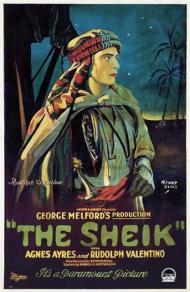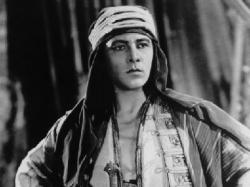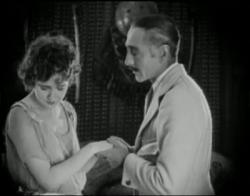Movie Review
The Sheik
A Photoplay Of Tempestuous Love Between A Madcap English Beauty And A Bronzed Arab Chief!
US Release Date: 11-20-1921
Directed by: George Melford
Starring▸▾
- Rudolph Valentino, as
- Sheik Ahmed Ben Hassan
- Agnes Ayres, as
- Lady Diana Mayo
- Patsy Ruth Miller, as
- Zilahl
- George Waggner, as
- Yousaef
- Adolphe Menjou, as
- Raoul de Saint Hubert
- Frank Butler, as
- Sir Aubrey Mayo
- Charles Brinley as
- Mustapha Ali
![2.5 star[s] out of 4](http://www.threemoviebuffs.com/static/images/global/featured_gold_stars.png)

Rudolph Valentino in the role that made him a star in The Sheik.
This desert romance-adventure made Rudolph Valentino a star. Women swooned at the very mention of his name while their husbands reacted with jealous anger. As Sheik Ahmed Ben Hassan, Valentino created his most lasting role, the one, in fact, that he would be stereotyped for during the remainder of his tragically short life. The image of the turbaned, swarthy sheik seductively staring at the frightened white woman in his clutches is, indeed, an iconic moment of the cinema.
The Sheik tells the story of the cultured yet adventurous Lady Diana Mayo (Agnes Ayres). She meets the young sheik at a casino in a desert city after dressing in the guise of a harem dancer and sneaking into the 'Arab' only gambling place. Once the Sheik (who was raised in Paris and is really the child of an English father and Spanish mother) sees the beautiful white woman he is instantly attracted. He plans to abduct her once she sets off on a desert safari, but first he climbs a balcony to sneak into her room and serenade her with “Beautiful Dreamer".
After the abduction Diana is at first repelled by Ahmed's rough and demanding personality. Especially when Dr. Raoul de Saint Hubert (Adolphe Menjou), her novelist friend from the 'civilized' world, comes for a visit and finds her a prisoner of the Sheik. Soon, however, her feelings turn from fear to attraction at the same time that his go from an obsessive lust to a tender love.
Feminists would be appalled by the Sheik's attitude toward women. At one point he tells the doctor that when an Arab sees a woman he likes, he takes her. Another time when Diana tells him she is not used to being given orders he replies… “You will learn."
The movie turns into an adventure story when Omair the bandit captures Diana while she is out riding in the desert with the Sheik's French valet, Gaston. The lovely Lady manages to scrawl a hasty message in the sand that reads… “Ahmed I love you". This leads to the movies climax as the Sheik rides to her rescue.
Rudolph Valentino was a beautiful man with incredible screen presence. And although his techniques of seduction (intense stare, nostril flare and toothy grin) seem laughable today, they drove audiences wild in 1921. The Sheik is, quite simply, the granddaddy of all camp classics.
![2.5 star[s] out of 4](http://www.threemoviebuffs.com/static/images/global/featured_gold_stars.png)

Yeah, he wants her!
Because of the Twilight films, I now understand why women liked this movie. A fairly bland woman has three men fighting over her. This is a female fantasy, Two Arabs are horny for her, making her feel powerful and important. Ayres is not all that attractive, but these two men want to boink her because she is a white women in a part of the world where most women are darker skinned. The third man that wants her is another westerner whose marriage proposal she turns down.
Valentino was dopey looking. His smiles and gestures make him look ridiculous. The one and only emotion he convincingly shows is lust. It is clear what his intentions are, until her crying warms his heart and cools his libido. Like I said, it is a female fantasy. She is clearly not the first woman he has forced himself on, but the movie never says why her objections are endearing, This again feeds into the fantasy that all this rich, exotic horndog needs is a woman to show up and give him a little grief about giving up the booty, to make him fall in love with her.
The Sheik is a classic for what it represented at the time. This movie shows an independent woman, who turns away admirers and wants some adventure. It also shows a timeless theme that women want to be treated with respect, and know that they turn the man they love on.

Agnes Ayres and Adolphe Menjou in The Sheik.
This movie plays out like an early Harlequin romance novel. Lady Diana is free-spirited and strong willed. She's not like any woman the Sheik has met in a long time. Every woman in the desert obeys his every command, so her refusal to bend to his will is an intriguing challenge to him.
Diana finds a similar appeal in the Sheik. He's very different to the other men in her life, being a "savage". Later, she makes this revealing statement that must have resonated with female audiences of the time, "The men in my life have not known the meaning of tenderness - have thought only of themselves." After the Sheik hears this, he begins to understand her and his attitude softens, while still remaining enough of a he-man to rescue her from desert bandits.
The story was based on a wildly successful novel published in 1919. One important scene was removed in the transition to the silver screen. In the movie, the Sheik stops making advances towards Diana when she begins crying in his tent that first night, but in the book he rapes her repeatedly. In defending the plot point of having her heroine fall in love with her rapist, author Edith Hull said, "I am old fashioned enough to believe that a woman's best love is given to the man she recognizes as her master."
I agree with you Eric that Valentino can be dopey looking at times. His best look is when he is brooding. The few times where he isn't smiling too broadly or opening his eyes way too widely are his best moments. He conveys much more emotion when he's not "acting" than when he's actually trying to.
The other actors are just as guilty of hamming it up as he is. Whenever anyone appears in close-up they start projecting to the balcony seats. Did they not realize how big they were going to be up on the screen? Although many silent films of the era feature such unrestrained acting, there were also others of a much more subtle nature, but not so here.
Apart from the broad acting, there are other unintentionally amusing moments. The message scrawled in the sand that you mentioned Patrick, gave me a chuckle. She writes in the sand with her finger and somehow the message remains as pure as when she wrote it despite being out in the open, exposed to the wind, and despite the fact that a battle on horseback takes place all around it.
Another scene worth a smile is when the Sheik and his writer friend start to fight over Diana. Instead of throwing punches, they press their bodies tightly together, their faces just inches apart, and stare deeply into each other's eyes. I mean, are they fighting because they love her or each other?
The ending of the movie is of course a sign of the times. In an era when anti-miscegenation laws were still in effect all over the country, no way was Hollywood going to show a white woman with an Arabic man. You'll notice they never even kiss, despite the Sheik's attempts at seduction. When we learn that he is really of European descent, then of course they are free to do as they please.
Although considered a classic, The Sheik hasn't aged well at all. It's a curiosity at this point and of interest only to film buffs.
Photos © Copyright Famous Players-Lasky Corporation (1921)
